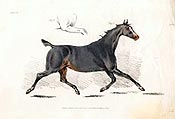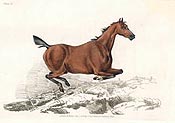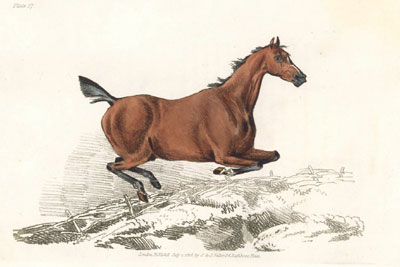|

Grey horse pictures

Composite horse pictures

Bay and chestnut horse pictures
|
Horse Pictures - The Bucking Leap
Antique pictures of
horses
|
The Beauties and Defects in the Figure of the Horse
Delineated in a Series of Coloured Plates
by H. Alken
Published in London by S. and J. Fuller at the
Temple of Fancy, 34 Rathbone Place
|
 |
|
Notes accompanying this plate
The Bucking Leap
This leap is
similar to the action of the deer; and the horse, in
the performance of it, displays a very grand and
prepossessing appearance. There ought to be a great
distinction between the action of the animal, in
this leap, and in that which I before described: for
although I have just remarked on the propriety of
the horse gathering his quarters under him, I do not
consider this rule as applicable to the fly leap. It
is but rarely indeed that any but very hot horses
follow this method, which certainly is not a good
one. In the first place, the action itself requires
great exertion, both on the part of the rider and
the horse, an effort which is not at all calculated
for endurance: secondly, it is very dangerous, as
the horse addicted to it seldom knows whence to
spring, or to take off from, or how to measure his
leap; and it very often occurs that the animal,
having his head cleaving the air, entirely forgets
to put his fore-legs down on the ground, and
consequently he comes bolt on his knees and chest. I
rode a mare of this description for two seasons; she
was four years old, and excessively violent,
although a powerful leaper as to height and
distance. For the first season I had four or five
falls a day, upon an average, and all in consequence
of her violent bucking leaps. |
|
The picture above is an
illustrated plate from the 1816 publication, the inside title page of which
is reproduced here along with the introduction to the book
 "By
a detailed series of graphic and descriptive illustrations, it is the
intention of the Author of this Work to show the good and bad points in
that most useful and noble animal the Horse. He has adopted the mode of
detaching various parts of the subject, because, by comparison of the
distinct appearances, the general impression upon the memory of the
reader is much likely to be much stronger than could result from the
study of any treatise of a less abstracted nature; to understand which,
a knowledge of anatomy, or a constant reference to some scientific work
is indispensable. "By
a detailed series of graphic and descriptive illustrations, it is the
intention of the Author of this Work to show the good and bad points in
that most useful and noble animal the Horse. He has adopted the mode of
detaching various parts of the subject, because, by comparison of the
distinct appearances, the general impression upon the memory of the
reader is much likely to be much stronger than could result from the
study of any treatise of a less abstracted nature; to understand which,
a knowledge of anatomy, or a constant reference to some scientific work
is indispensable.
This Publication is also intended as a
Book of Lessons for such young Artists as are inclined to pursue the
study of the Horse in all the different points of his figure and action.
There is no animal whose countenance
combines such correct and powerful expressions of character. The
physiognomy of the Horse, therefore, illustrating the different passions
to which he is subject, as well as the natural bias of his temper and
disposition, is an important branch of study to gentleman of the turf,
and to young purchasers; for it is generally considered, that to timid
riders and drivers, the temper of the beast is of more consequence than
any bodily blemish.
In this point of view, therefore, the
Author flatters himself that his Work will be found useful; and as his
remarks are the result of the most attentive observation during many
years, entirely devoted to the pleasures of the field, he trusts that
the general principles which he has laid down, as well with respect to
power, strength, and the various points of action as to the
physiognomical character and figure of the horse, will be found fairly
elucidated in the following series." |
|

